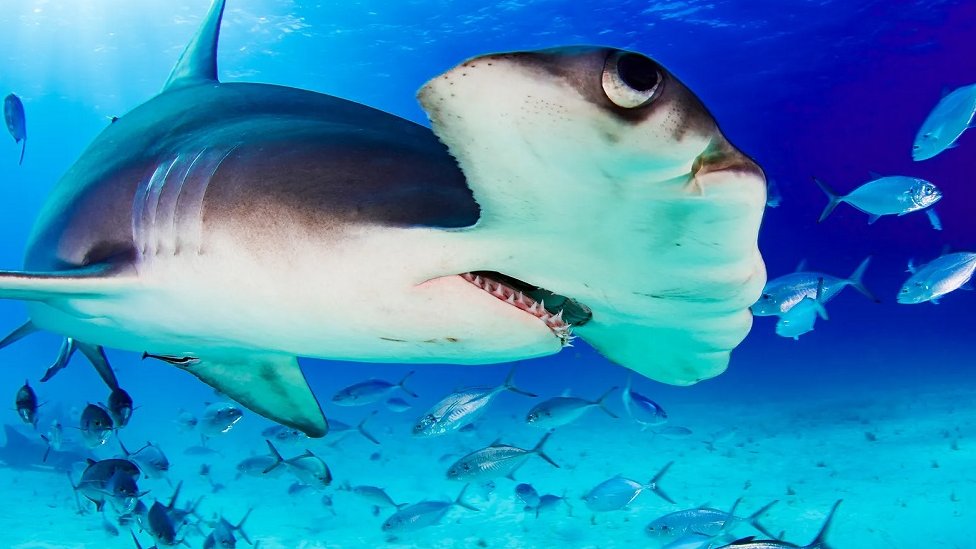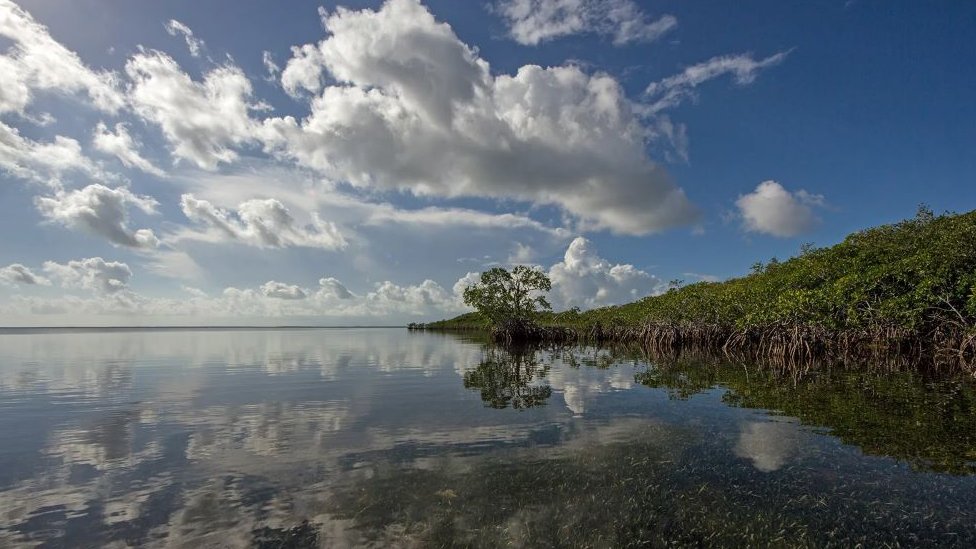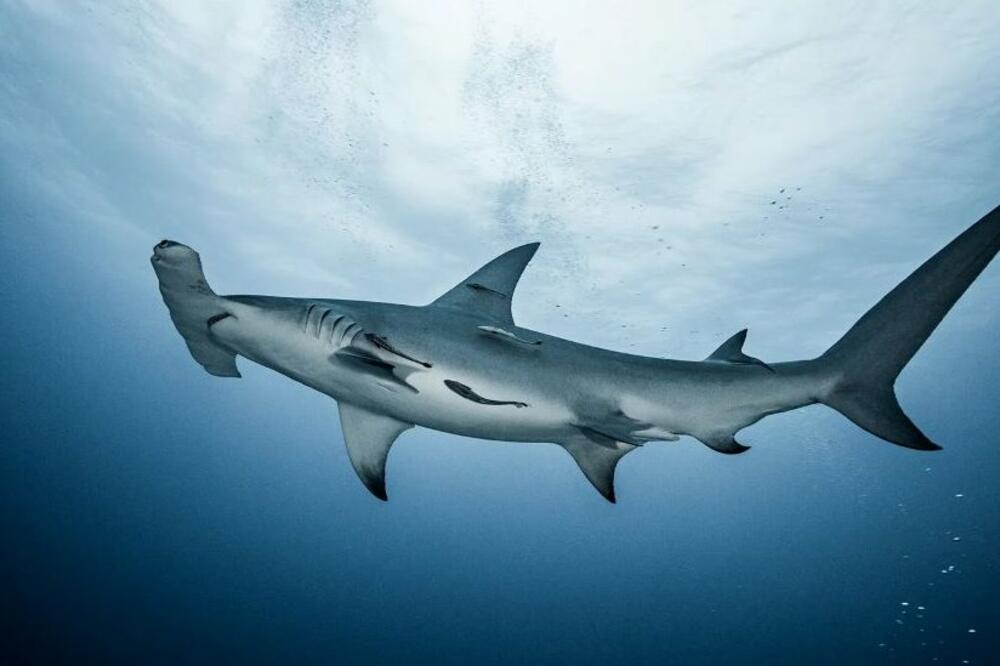Great hammerheads are mysterious, strange-looking creatures, but scientists may have found the first nursery of these huge sharks, and it's in one of the world's most visited fishing grounds.
Few shark species can attract as much attention as great hammerheads.
As well as all sharks of the family Sphyrnidae, the large hammerhead has a head that looks less like something a living thing would have and more like a spare part of a prototype race car.
The eyes are located at the ends of the aerodynamic spoiler (the technical name "cephalofoil") above the jaws, which resembles a lifting platform on an aircraft.
- Should swimmers in the Adriatic Sea be afraid of shark attacks?
- What human traces are hidden in the bottom of the ocean
- Why was the largest megalodon shark exterminated
Even after decades of research, we are still not entirely clear about the evolutionary forces that led to the strange shape of the hammerhead skull.
Most likely, this is because such a shape of the skull helps them to better pick up the electrical signals sent by their favorite prey - stingrays - which hide under the sand.
The underside of the head is dotted with electroreceptors, pores that detect the electromagnetic fields produced by living things, although research has found that this sense is not used more skillfully from sharks that have a normal head shape.
The hammer-shaped head can also be used as a prey immobilization weapon.
The position of the eyes at the ends of the aerodynamic spoiler gives them better depth perception, and the split nostrils allow them to "feel" more different smells in the water while swimming.
In addition to the strange head, the great hammerhead (Sphyrna mokarran) has another peculiarity that attracts attention.
That's their size.
The largest hammerhead caught it was 6,1 meters long, about the same as the largest great white shark measured.
The Great Hammerhead is one of the largest predatory sharks and looks stunning when it swims towards you.
However, most of the lifespan of such a large and physically impressive shark is a secret.
Shallow water and open sea tours all over the world, from Australia to the west coast of Africa.
But oceanology knows little about the places where they mate and give birth to young.
But marine biologists in Florida think they've finally found such a place.
Great hammerheads are no strangers to Florida waters.
They are often the target of local sport fishermen and can often be caught close to shore at night when they swim into shallow waters to hunt for prey.
However, a permanent population of adult sharks does not necessarily mean that they reproduce here.

Catherine MacDonald, Director Program for research and protection of sharks at the University of Miami, believes researchers have finally found a breeding ground for great hammerhead sharks.
And that place is not in some remote corner of the remaining protected mangrove forests in the state, but in one of the most developed parts of the southeast coast of Florida - in Biscayne Bay, which stretches south from Miami to the Florida Keys archipelago.
Like many other large shark species, great hammerheads do not lay eggs, but give birth to live young.
The tiny hatchlings spend their first year feeding on small fish in the sheltered shallow waters of the bay and mingle with the hatchlings of other hammerhead species, making them difficult to identify.
"We just caught one," MacDonald says, referring to the the first baby great hammerhead to be captured in this area in 2018.
"I mean, we didn't expect it, we didn't really ask for them."
“We've been doing our regular shark surveys in coastal waters… we know that there are some other species that we're monitoring that are breeding in this area.
"We are interested in the reproduction of those other species.
"And then one of them just appeared.
"And we even wondered for a moment, 'Is this really a big hammerhouse?'
"We were like, 'this is weird.'
"But every now and then, we catch something unusual.
"There are a lot of species that we see maybe a few times a year, but we've continued to catch [large hammerheads], the smaller ones.
"And then at some point we realized, 'This is more than a coincidence.'"
With support from National Geographic, Macdonald and her team began fitting them with tracking devices to learn how the habits of great hammerheads change and how they use this habitat as they grow and age.
Macdonald emphasizes that for many species of sharks there is not enough evidence to determine exactly where they breed.
"Even for well-studied species, such as the great white shark, there are still not all the answers about where they breed and how the young use the habitats, although we are getting answers to some questions.
"And of course about mating, which is even more difficult to trace".
It is much easier to learn about the habitats of those species of sharks that spawn in shallow coastal areas, Macdonald adds.
"Because we know a lot more about shallow coastal habitats, because they're close and we spend a lot of time there."
In 2021, McDonald published a paper in which Biscayne Bay designated as a possible great hammerhead nursery.
Hatchlings are seen there year after year, and are more likely to be found there than anywhere else, although further research will tell if the hatchlings stay longer in Biscayne Bay.
Placing trackers on small sharks, such as juvenile great hammerheads, can often be a challenge, McDoland says, because it requires a completely different approach than tagging large sharks swimming in the open sea.
The bigger the big hammerhead, the more tempting the target - for both commercial and sport fishing.
"We mostly collect data on large sharks in the open sea through satellite tracking devices.
"But these devices are too big for small sharks to carry," she says.
"We investigate our cubs mainly through acoustic monitoring devices, which are implanted in their bodies and have a lifespan of 10 years.
“But they only work when the animal passes near the receiver.
"They work much better in shallow coastal environments that have good coverage than in open sea or offshore environments."
Great hammerheads are now believed to travel long distances during annual migrations, but exactly where the population moves off the coast of Florida remains unknown.
The same sharks seem to visit the Bimini archipelago in the Bahamas year after year in the winter, according to research by shark expert Dave Portnay.
The bigger the big hammerhead, the more tempting a target it is -- for both commercial and sport fishing, says Hana Med, director of the non-profit Shark Conservation Organization. American Shark Conservancy (ASC).
Mead, who is based in West Palm Beach, north of Miami, wanted to learn more about the population of great hammerheads in Florida waters and how genetically healthy they are, which could answer the question of how far they travel.

Recent a study on the genetics of great hammerheads, by a private university in Fort Lauderdale, Nova Southeastern University, she revealed surprising findings.
"There is inbreeding," says Med.
"They're these big animals that make big movements, and we assumed they were pretty genetically healthy."
During the five years of the program carried out by Medi and her team, tracking devices have been placed on 23 large hammerheads, largely thanks to the support of local sport fishermen.
The researchers found that large predators such as great hammerheads are rarely seen even in areas known to be home to permanent populations, and populations appear to have declined due to overfishing.
"I think their number is naturally low. They are big animals," she says.
"Their numbers are certainly affected by overfishing along the east coast of the United States."
There are many sport fishermen in Florida.
More than a million people in Florida currently have license for fishing at sea.
"Florida is an extremely popular place for sport fishing," says Med.
"And they usually target the big sharks, because it's more fun to fight them."
Med wants to examine the impact of sport fishing on the Great Hammerhead population in Biscayne Bay.
Among other things, because great hammerheads are more affected by fishing than some other shark species.
Even when the fish is back in the water, the consequences of the catch can be deadly.
Great hammerheads are such powerful swimmers that they actually exhaust themselves to death trying to avoid longlines, explains Med.
"They outgrow their ability to breathe and process the toxic byproducts that are created during exercise...to the point where they can't survive."
On the other hand, nurse sharks tolerate capture quite well.
"When we catch a nurse shark, it comes up and waits until it rises.
"So when we pick her up, she's not tired at all, just a little grumpy."
Commercial fishing boats are known to keep longlines in the water for up to 12 hours, she says.
"If a shark is hooked for that long, the survival rate is very low."
It is more difficult to calculate the number of great hammerheads that are killed by sport fishing, especially if the shark is alive when released, but later dies of shock.
"The number of those who die that way is not always known," says Med.
"So they are not included, which can lead to over-exploitation".
Med says the ASC helped make the first population census of hammerhead sharks in Florida waters.
"That was the first time we looked at that group as a whole ... and really factored in all the data we have from sport fishing.
"The list brings together all these data".
Although the study will not be published before the end of the year, preliminary findings indicate that the number of dead hammermen is higher than estimated, says Med.
However, Mead and McDonald both believe that sport fishing can be more of a help than a hindrance as long as it is carefully managed.
"Even if you don't care about it for other reasons, you still feel like you want it to be there for your kids and your grandkids," McDonald says.
Biscayne Bay is already a national park, but scientists are calling for stricter protection measures.
It is already considered that the rise in sea temperature due to climate change will be reflected on corals in and out of the bay.
They can also affect the health of young, developing sharks.
"We've just had an unseasonably hot summer here in Miami," McDonald says.
"In the bay, the water temperature was or reached 38 degrees Celsius.
"It's the temperature of human blood."
Because they are cold-blooded animals, the temperature of the water around their large, hammer-shaped heads helps them regulate their internal temperature, McDonald says.
"We know that we generally see a more pronounced stress response to something like catching in warmer water.
"I also worry that as the water warms, some of the ways humans endanger them will become more intense because of the animal's metabolic response to that warmer water."
Even if their vulnerability to sport fishing remains the same, the probability of a shark surviving an encounter with a fisherman may be lower, she adds.
"Our evidence shows that these animals are using habitats outside of Biscayne National Park," McDonald says.
"Those habitats are important to them.
"Biscayne National Park has slightly, but not much, stricter fishing regulations than other waters around Florida.
"I think there is a lot of room to regulate it."
If it doesn't touch, big hammer can live up to 44 years, making it one of the longest-lived scavengers on Earth.
Females give birth to relatively few babies since they carry them for a year in their stomachs, which means that their number is slowly replenished.
But they have surprisingly large brains packed into their oddly shaped skulls - they are quite large compared to their body mass and they have a great layering, which speaks of the complexity of the brain.
Clearly, there is much more to learn about these strangely shaped and mysterious creatures.
And if they rely on the busy and increasingly warm waters around Florida to raise their young, then they face a tough future.
"We've been catching juvenile hammerheads with an angler hook in their jaws," says Macdonald.
"And on the one hand, that's a very optimistic sign, isn't it, because that animal has already encountered fishing gear and apparently survived.
"And on the other hand, it is also an indicator of the types of threats to which they are exposed".
Also watch this video:
Follow us on Facebook, Twitter i Viber. If you have a topic proposal for us, contact us at bbcnasrpskom@bbc.co.uk
Bonus video:




